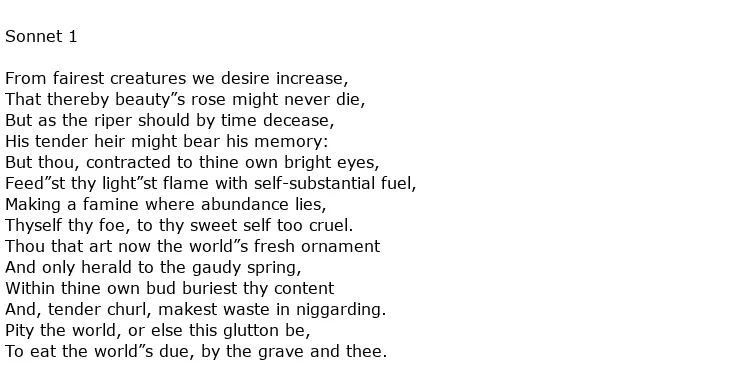William Shakespeare (1590-1613), widely known as “The Bard,” stands as perhaps the most recognized figure in literary history. While his 37 plays justly command immense attention, it would be a significant oversight for any reader or scholar, particularly those devoted to poetic arts, to overlook his substantial body of over 150 poems. Shakespeare’s skill in weaving profound human insights with creative linguistic expression extends far beyond the theatrical stage, establishing him as a towering figure in poetry whose influence resonates through centuries.
Contents
The Mastery of the Shakespearean Sonnet
Shakespeare is most famously associated with his collection of 154 sonnets. A sonnet, traditionally a fourteen-line poem with a specific rhyme scheme, became a vehicle through which The Bard demonstrated unparalleled command over form and content. Unlike simple rhyming verse, Shakespeare infused the sonnet structure with deep philosophical thought and intricate emotional exploration. This ability to maintain intellectual integrity within a rigid form is a hallmark of his genius. His approach to this structure has even given rise to its own nomenclature: the English or Shakespearean sonnet. This structure typically follows an ABAB CDCD EFEF GG rhyme scheme, culminating in a final rhyming couplet that often provides a summary or twist.
Let’s examine his very first sonnet to see this structure in action:
 A close-up image displaying the text of William Shakespeare's Sonnet 1, lines 1-14, demonstrating the structure of a Shakespearean sonnet with visible text characters.
A close-up image displaying the text of William Shakespeare's Sonnet 1, lines 1-14, demonstrating the structure of a Shakespearean sonnet with visible text characters.
Here, the distinct verbal rhythm, separate from the end rhymes (A,B,A,B, C,D,C,D, E,F,E,F, G,G), creates a flow that is best appreciated through oration. Studying sonnet examples, especially Shakespeare’s, offers invaluable insight into poetic craft.
Themes and Historical Context
Compared to the thematic diversity of some later poets, Shakespeare’s sonnets might appear limited in scope, often circling around themes of love, beauty, time, and mortality. However, understanding the historical context of the Elizabethan era is crucial. During this period, making a living as a writer was challenging. While plays were gaining popularity, poems, particularly sonnets, were often commissioned or dedicated to wealthy nobles and members of upper society. Parchment was also a valuable commodity, meaning every line counted. Thus, poems often needed to cater to the tastes of potential patrons, and what better subject during the Elizabethan era than love? Many of his poems delve into the complexities of romantic affection, desire, and relationships, fitting seamlessly within the category of love and sweet poems.
Beyond the Sonnets: Narrative Poems
Less widely known than his sonnets are Shakespeare’s two significant narrative poems, Venus and Adonis and The Rape of Lucrece. Composed early in his career, around 1593 and 1594, these lengthy works demonstrate his ability to construct compelling stories within poetic form. It’s plausible that these were experimental works or perhaps attempts to find a different market, given that plays were not always lucrative.
Venus and Adonis
The earlier of the two, Venus and Adonis, was dedicated to the Earl of Southampton, a key patron. This poem vividly retells a myth from Ovid’s Metamorphoses. It explores themes of love, desire, and rejection, showcasing Shakespeare’s keen observation of human (and mythological) nature. The poem’s lush descriptions and dramatic narrative highlight his capacity for intricate storytelling, connecting ancient mythology with contemporary poetic sensibilities.
The Rape of Lucrece
Written shortly after Venus and Adonis, The Rape of Lucrece is a darker, more psychologically intense narrative poem. It recounts the story of the virtuous Roman noblewoman Lucretia, her rape by Tarquin, and her subsequent suicide, leading to the overthrow of the Roman monarchy. The poem delves into themes of honor, shame, tyranny, and moral outrage. Its exploration of crime, psychological distress, and tragic consequence shows clear thematic links to his later dramatic works, such as Hamlet and Macbeth. Some scholars view this poem as an early exploration of themes and character types that would later dominate his tragedies.
The Enduring Influence of the Bard’s Poetry
For aspiring poets and dedicated readers, studying the work of William Shakespeare is essential. His sonnets offer masterclasses in wordplay, structure, and condensing complex ideas into a compact form. His narrative poems, meanwhile, provide lessons in character development, dramatic pacing, and vivid description within a non-dramatic structure. Many modern poets acknowledge his foundational influence, having read and even consciously or unconsciously echoed his techniques and themes. The enduring power of a beautiful poems of life or love often traces its lineage back to the forms and expressions honed by Shakespeare. As “The Bard,” his poetic voice remains a cornerstone upon which much of subsequent English poetry is built. To truly appreciate the art form, one must engage with the words he has left us.
